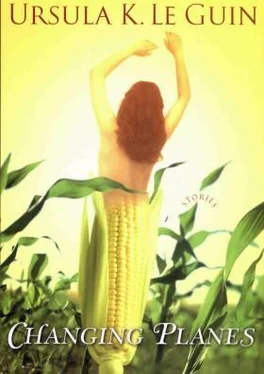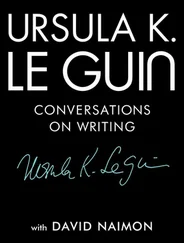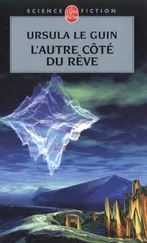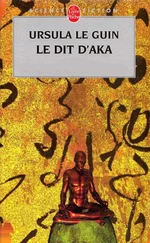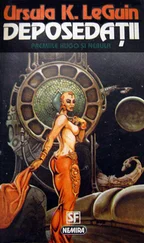It appears that in the language of the Nna Mmoy, not only the choice of word—noun or verb, tense, person, etc.—but the meaning of each word is continuously modified by all the words that precede or may follow it in the sentence (if in fact the Nna Mmoy speak in sentences). And so, after receiving only a few syllables, the translatomat begins to generate a flurry of possible alternate meanings which proliferate rapidly into such a thicket of syntactical and connotational possibilities that the machine overloads and shuts down.
Purported translations of the written texts are either meaningless or ridiculously various. For example, I have come upon four different translations of the same nine-character inscription: “All within this space are to be considered friends, as are all creatures under heaven.”
“If you don’t know what is inside, take care, for if you bring hatred in with you the roof will fall upon you.”
“On one side of every door is mystery. Caution is useless. Friendship and enmity sink to nothing under the gaze of eternity.”
“Enter boldly, stranger, and be welcome. Sit down now.” This inscription, the characters of which are written so as to form a shape like a comet with a radiant head, is often found on doors, box lids, and book covers.
The Nna Mmoy are excellent gardeners, vegetarians by necessity. Their arts are cookery, jewelry, and poetry. Each village is able to grow, gather, and make everything it needs. There is some commerce between villages, mostly involving cooked dishes, special preparations of the rather limited vegetable menu by professional cooks. Admired cooks barter their dishes for the raw materials produced by the gardeners, with a bit over. No mining has been observed, but opals, peridots, amethysts, garnets, topazes, and colored quartzes may be picked up in any stream bed; jewels are bartered for unworked or reused gold and silver. Money exists but has only a symbolic, honorary value: it is used in gambling (the Nna Mmoy play various low-keyed gambling games with dice, counters, and tiles) and to buy works of art. The money is the pearly-violet, translucent mantle, about the size and shape of a thumbnail, left by the largest species of jellyfish. Found washed up on the sea beaches, these shells are traded inland for finished jewelry and for poems—if that is what the written texts, single sheets, booklets, and scrolls, so beautiful and teasing to the eye, actually are.
Some visitors confidently assert that these texts are religious works, calling them mбndalas or scriptures. Others confidently assert that the Nna Mmoy have no religion.
There are many traces on the Nna Mmoy plane of what people from our plane call civilisation, by which people from our plane, these days, usually mean a capitalist economy and an industrial technology based on intense, exhaustive exploitation of natural and human resources.
Ruins of immense cities, traces of long roads and huge paved areas, vast wastelands of desertification and permanent pollution, and other evidences of progressive society and advanced scientific technology crop up among the fields and border the parklands. All are very ancient and seem to be quite meaningless to the Nna Mmoy, who regard them without awe or interest.
Which is how they also regard visitors.
No one understands the language well enough to know if the Nna Mmoy have any history or legends of the ancestors responsible for the vast works and destructions that litter their placid landscape.
My friend Laure says that he heard the Nna Mmoy use a word in connection with the ruins: nen. As well as he could figure out, the syllable nen, variously modified by the syllables that surround it, may signify a range of objects from a flash flood to a tiny iridescent beetle. He thought the central area of connotation of nen might be “things that move fast” or “events occurring quickly.” It seems an odd name to give the timeless, grass-grown ruins that loom above the villages or serve as their foundations—the cracked and sunken tracts of pavement that are now the silted bottoms of shallow lakes—the immense chemical deserts where nothing grows except a thin, purplish bloom of bacteria on poisonous water seeps.
But then, it’s not certain that anything has a name in Nna Mmoy.
Laure has spent more time in the “garden utopia” than most people. I asked him to write me anything he wanted about it. He sent the following letter:
YOU ASKED ABOUT THE LANGUAGE. You’ve described the problem well, I think. It might help to think of it this way:
We talk snake. A snake can go any direction but only one direction at one time, following its head.
They talk starfish. A starfish doesn’t go anywhere much. It has no head. It keeps more choices handy, even if it doesn’t use them.

I imagine that starfish don’t think about alternatives, like left or right, forward or back; they’d think in terms of five kinds of lefts and rights, five kinds of backs and forths. Or twenty kinds of lefts and rights, twenty kinds of backs and forths. The only either)or for a starfish would be up and down. The other dimensions or directions or choices would be either)or)or)or)or…
Well, that describes one aspect of their language. When you say something in Nna Mmoy, there is a center to what you say, but the statement goes in more than one direction from the center—or to the center.
In Japanese, I’m told, a slight modification in one word or reference changes a sentence entirely, so that—I don’t know Japanese, I’m making this up—if a syllable changes in one word, then “the crickets are singing in chorus in the starlight” becomes “the taxicabs are in gridlock at the intersection.” I gather that Japanese poetry uses these almost-double meanings deliberately. A line of poetry can be translucent, as it were, to another meaning it could have if it were in a different context. The surface significance allows a possible alternate significance to register at the same time.
Well, everything you say in Nna Mmoy is like that. Every statement is transparent to other possible statements because the meaning of every word is contingent on the meanings of the words around it. Which is why you probably can’t call them words.
A word in our languages is a real thing, a sound with a fixed form to it. Take cat. In a sentence or standing by itself, it has a meaning: a certain kind of animal; in talking it’s the same three phonemes, and in writing the same three letters c, a, t, plus maybe s, and there it is, cat. As distinct as a pebble. Or as a cat. Cat is a noun. Verbs are a little shiftier. What does it mean if you say the word had? All by itself? Not much. Had isn’t like cat, it needs context, a subject, an object.
No word in Nna Mmoy is like cat. Every word in Nna Mmoy is like had, only more so, much more so.
Take the syllable dde. It doesn’t have a meaning yet. A no dde mil as, that means more or less “Let’s go into the woods”; in that context dde is “woods.” But if you say Dim a dde mil as, that means, more or less, “The tree stands beside the road”: dde is “tree” and a is “road” instead of “go,” and as is “beside” instead of “into.” But then if that connotation group occurred inside other groups, it would change again—Hse vuy uno a dde mu as med as hro se se: “The travelers came through the desert where nothing grows.” Now dde is “desert land,” not “trees.” And in o be k’a dde k’a, the syllable dde means “generous, giving freely”—nothing to do with trees at all, unless maybe metaphorically. The phrase means, more or less, “Thank you.”
The range of meanings of a syllable isn’t infinite, of course, but I don’t think you could make a list of the possible or potential meanings. Not even a long list, like the entry for a syllable in Chinese dictionaries. A spoken Chinese syllable, hsing or lung, may have dozens of meanings; but it’s still a word, even though its meaning depends to some extent on context, and even if it takes fifty different written characters to express the different meanings. Each different meaning of the syllable is in fact a different word, an entity, a pebble in the great riverbed of the language.
Читать дальше
